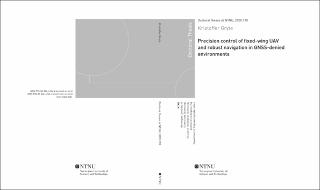| dc.description.abstract | Unmanned aerial vehicles (UAVs) have been adopted to a wide range of applications, but fully autonomous flight is still utopian, especially for safety-critical applications. This thesis seeks to close this gap by mainly considering robust navigation and precision control.
Navigation systems of safety-critical unmanned aircraft need an alternative position aiding source to global navigation satellite system (GNSS), as it is vulnerable to naturally occurring disturbances, such as ionospheric scintillation, and to malicious disturbances. Two promising alternatives, are position measurements from ultrawideband radio beacons and phased-array radio systems. Tight integration of ultra wideband (UWB) range measurements with real-time kinematic (RTK) aiding of inertial navigation for increased robustness to GNSS dropouts, is achieved using a double-differenced nonlinear observer. The results are verified using a simulated unmanned aerial vehicle (UAV) with realistic inertial, GNSS and UWB measurements. The phased-array-radio-based navigation system consists of a multiplicative extended Kalman filter that utilize these measurements, along with an exogenous altitude measurement, to provide corrections to the inertial navigation system, and performs measurement outlier rejection to mitigate effects of radio measurement reflections. In addition to providing a positioning solution, the navigation system make magnetometers and magnetic compasses made superfluous during flight, by providing heading estimates. The accuracy, reliability and versatility of the navigation system are demonstrated through three series of experiments. First, experimental results obtained from a multirotor and a fixed-wing UAV flight are presented, showing a 14% improvement in root-mean-square error compared to previous results. Then an online guidance, navigation and control system, based on the navigation system is demonstrated in beyond-visual-line-of-sight flights in controlled airspace, with a fixed-wing UAV, without the use of GNSS.
More precise control can enable the use of fixed-wing UAVs in a wider range of applications, in particular landing, without the use of a skilled remote control pilot. Commercial-off-the-shelf autopilots are reliable, given their extensive use and testing, and some even provide automatic landing capabilities. They are, however, not sufficient for automatic recovery in moving arrest systems, such as nets, which are simple infrastructures that can be installed in crammed or remote locations, such as aboard ships. Under general assumptions on the autopilot, it is extended by automatic plan generation, line-of-sight guidance along moving lines and enhanced RTK-GNSS positioning relative to the net, in a modular, non-intrusive manner to remain reliable. The system is demonstrated by two series of experiments; in a stationary net, to demonstrate controller performance, and in a manually moving net, to demonstrate compensation of arrest system motion.
Another landing strategy is through deep-stall, where the large increase in aerodynamic drag during stall is used to significantly reduce the speed, and thus impact, of the UAV during landing. One way to increase the precision compared to existing solutions, is through the presented nonlinear model predictive controller, which use a six degree of freedom model of the UAV to determine control surface deflections that will steer it to a desired landing location, along a predetermined decent angle, while minimizing speed and respecting dynamic and actuator constraints. An extensive simulation study shows that the controller handles a large span of wind speeds, but is sensitive to wind gusts.
To enable operation in a wider range of conditions, path following for fixed-wing UAVs should emphasize mitigation of wind effects, which at the very least implies a formulation using course angles. In this thesis, this is achieved by basing the guidance law on the coordinated turn equation, which is derived in in a general form for completeness, to ensure that no effects are unintentionally ignored. By cascading the coordinated-turn based controller with a line-of-sight guidance law, uniform semiglobal exponential stability of the cross-track error and course angle is proven. The controller is easy to tune, in terms of damping ratio and bandwidth. Through a comparative simulation study to the state-of-the-art, four guidance laws based on the analysis are shown to reduce the maximum cross-track error by 10% in wind. The system shows merit through an experimental verification.
Mathematical models of UAVs can be used both to obtain higher precision control, through model-based control techniques, to improve robustness, through e.g. fault detection, and to cut development time, cost and risk, through a simulator. For this reason, a complete six degrees-of-freedom UAV model is presented, based on a combination of wind tunnel testing and numeric analysis for the aerodynamic model, wind tunnel testing for the propulsion model, and bifilar pendulum testing to identify moments of inertia. | en_US |
